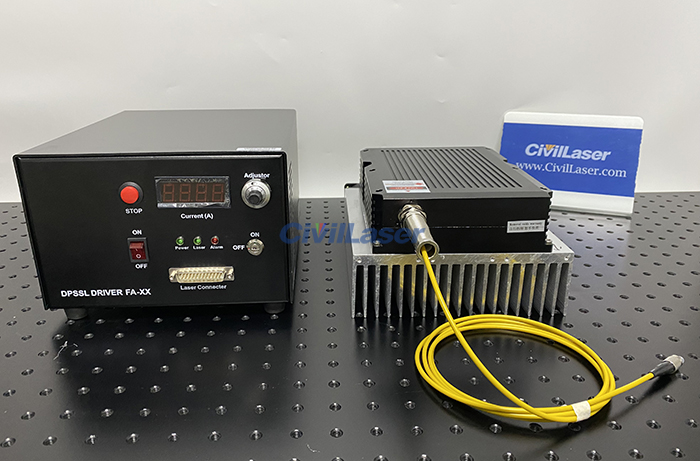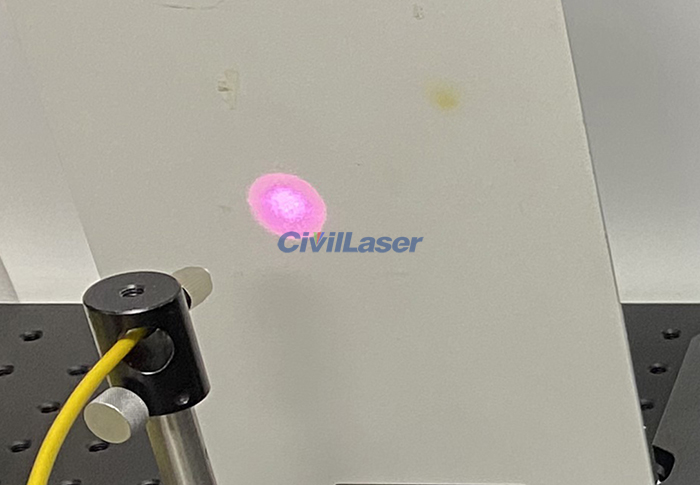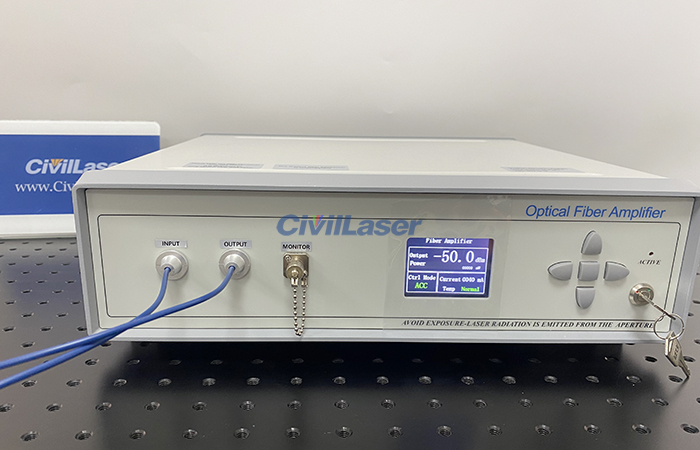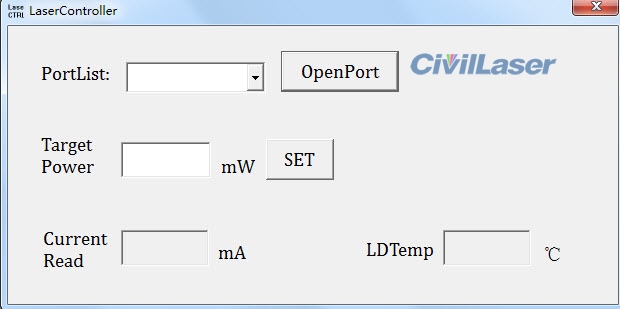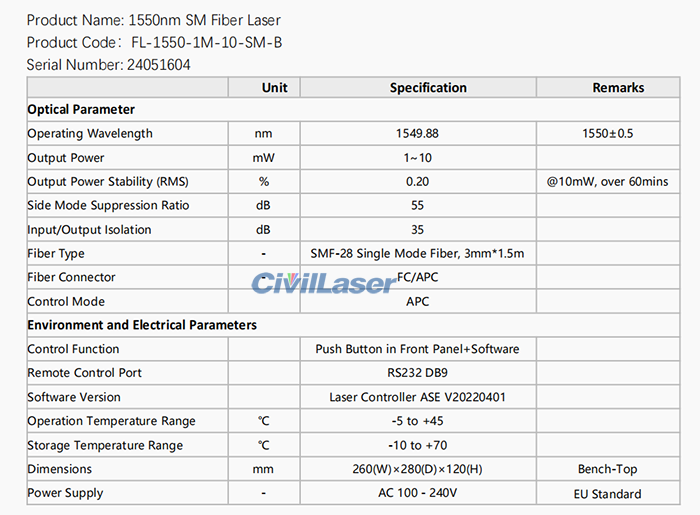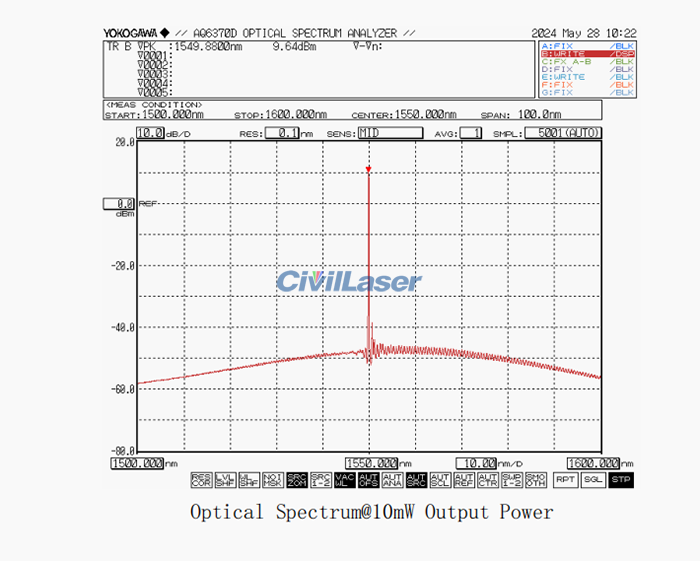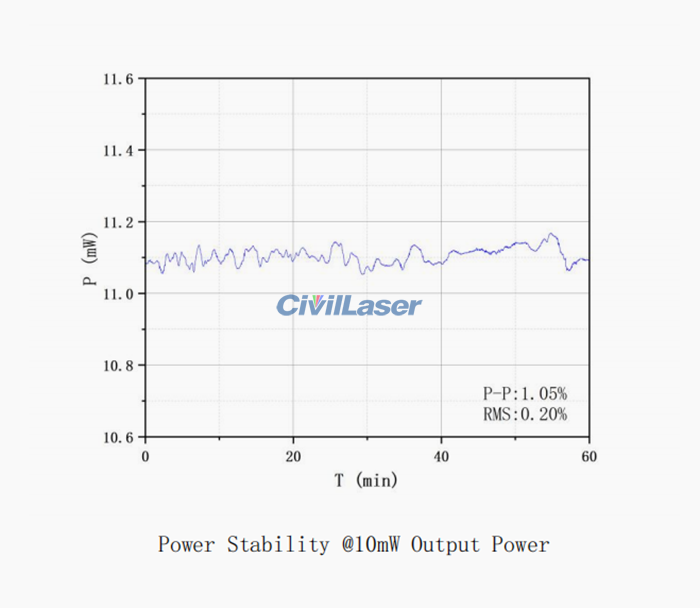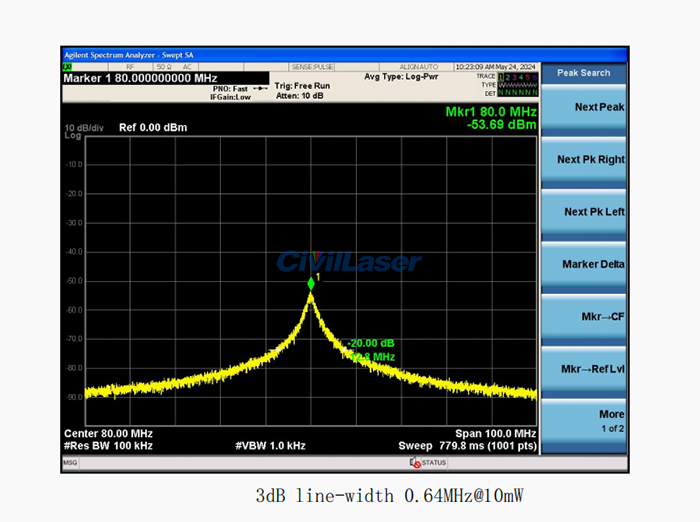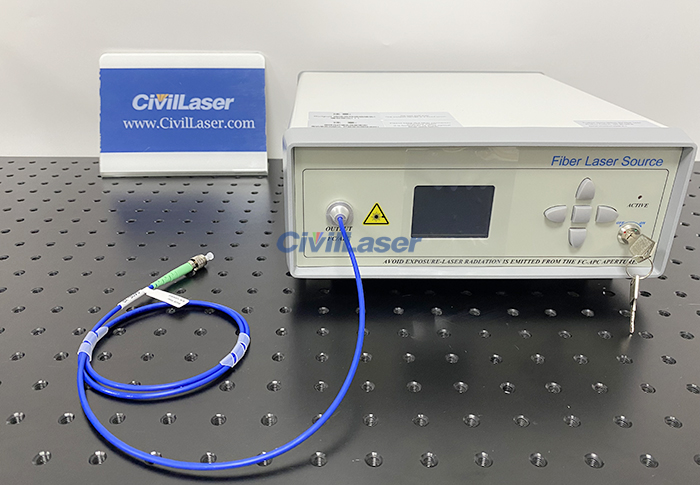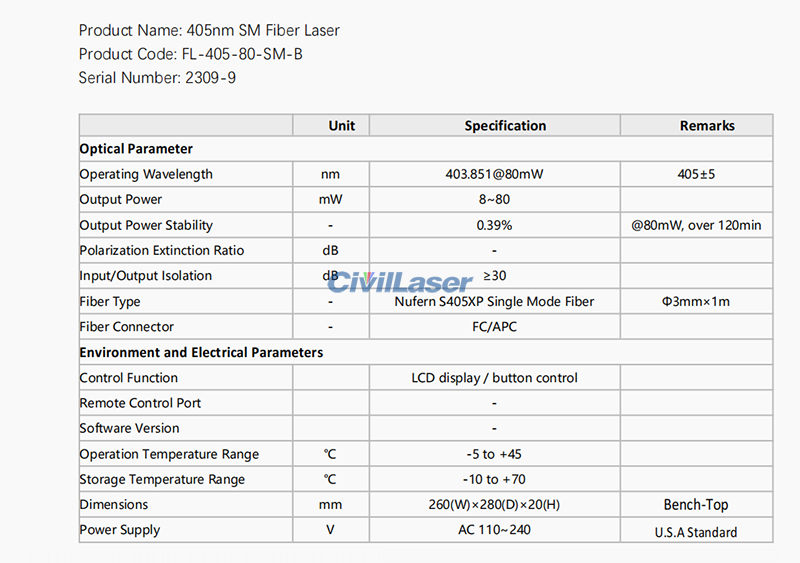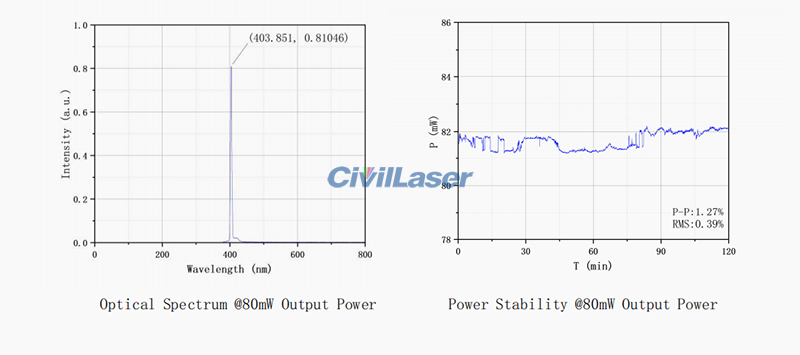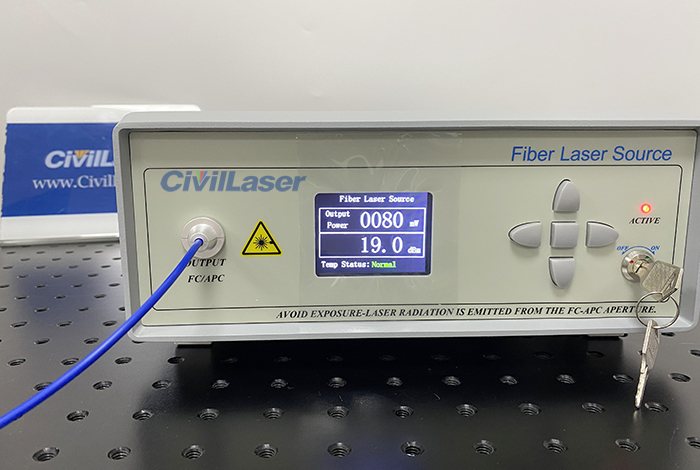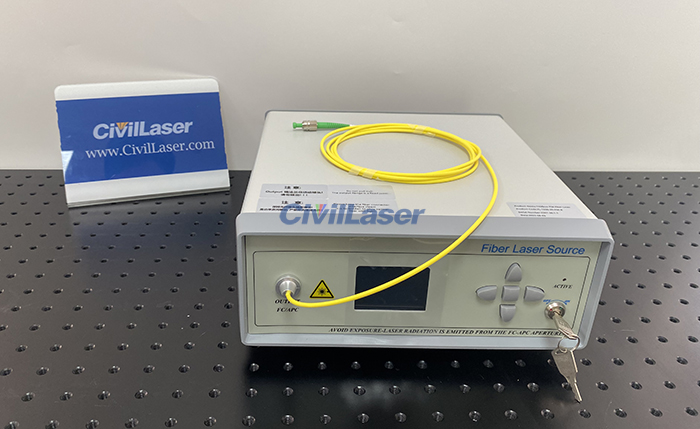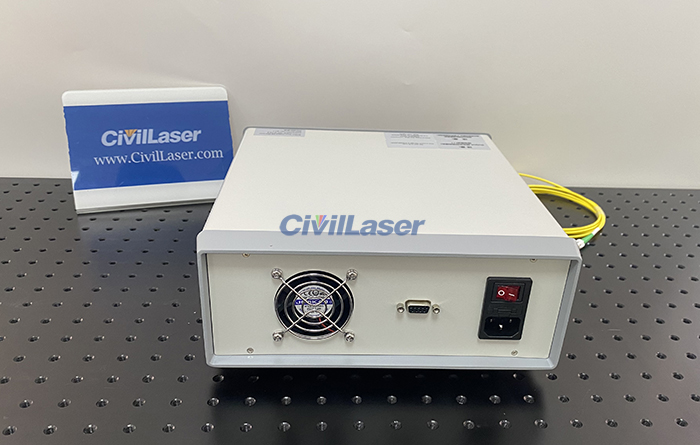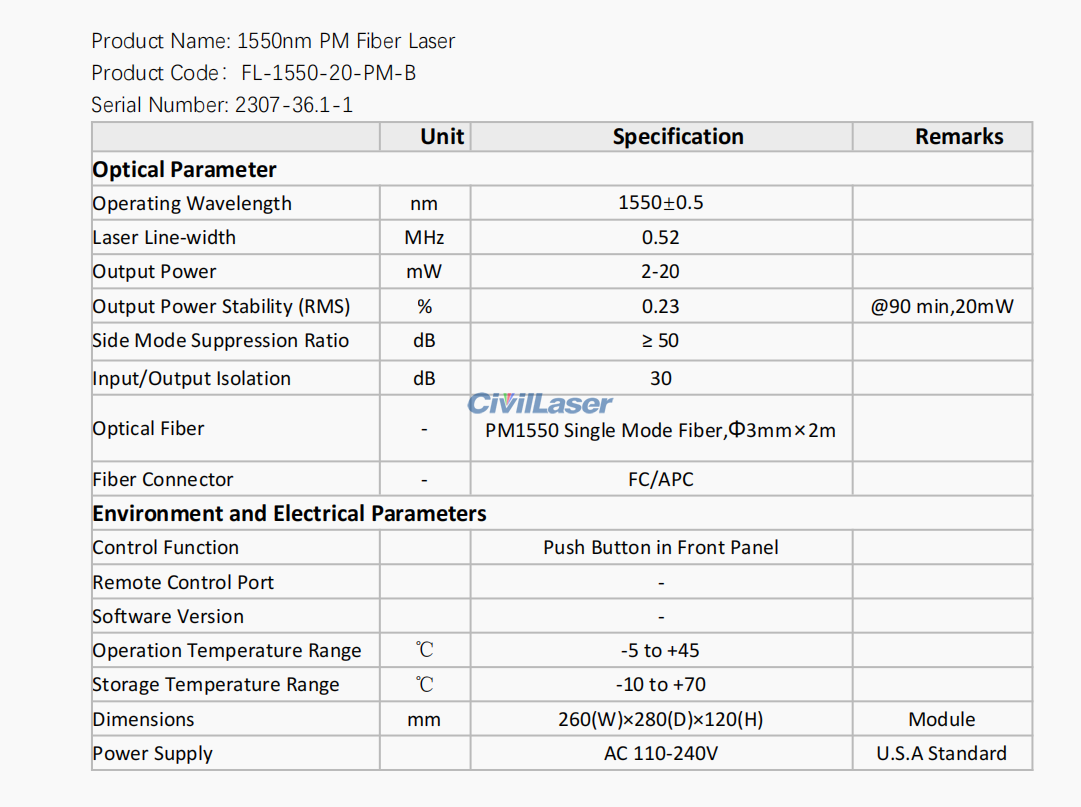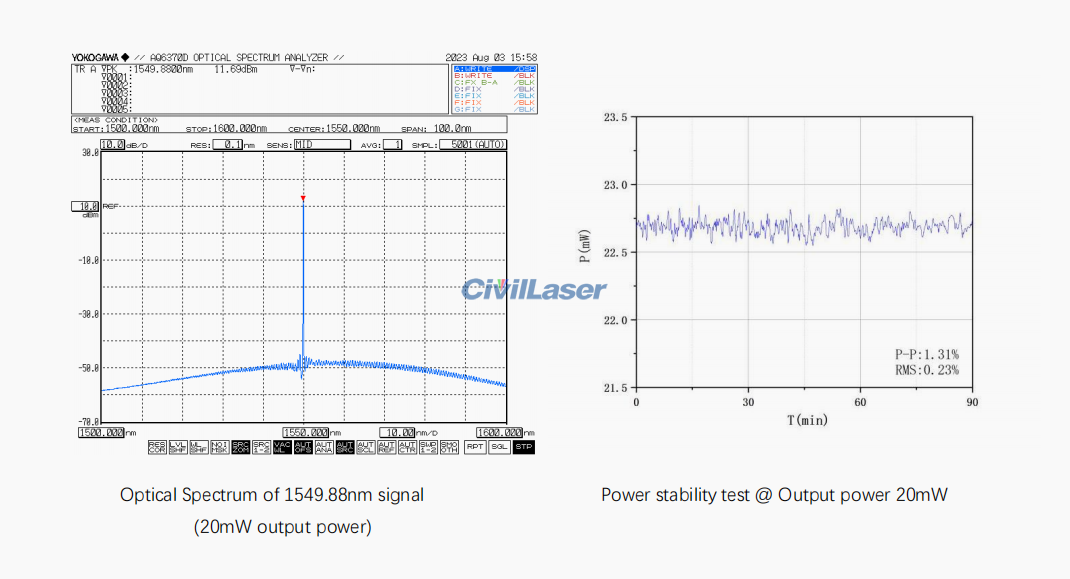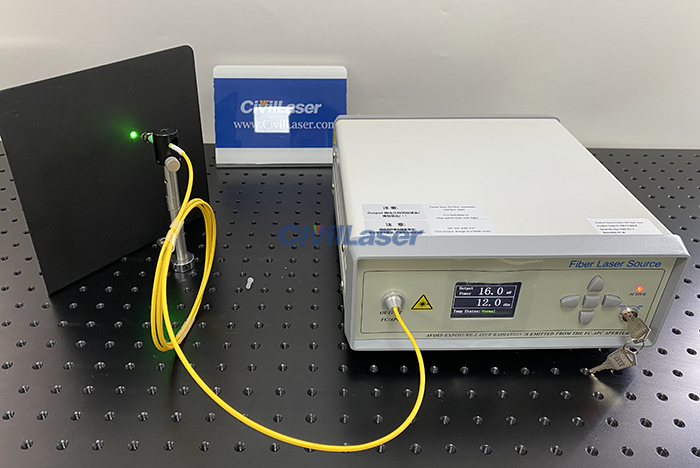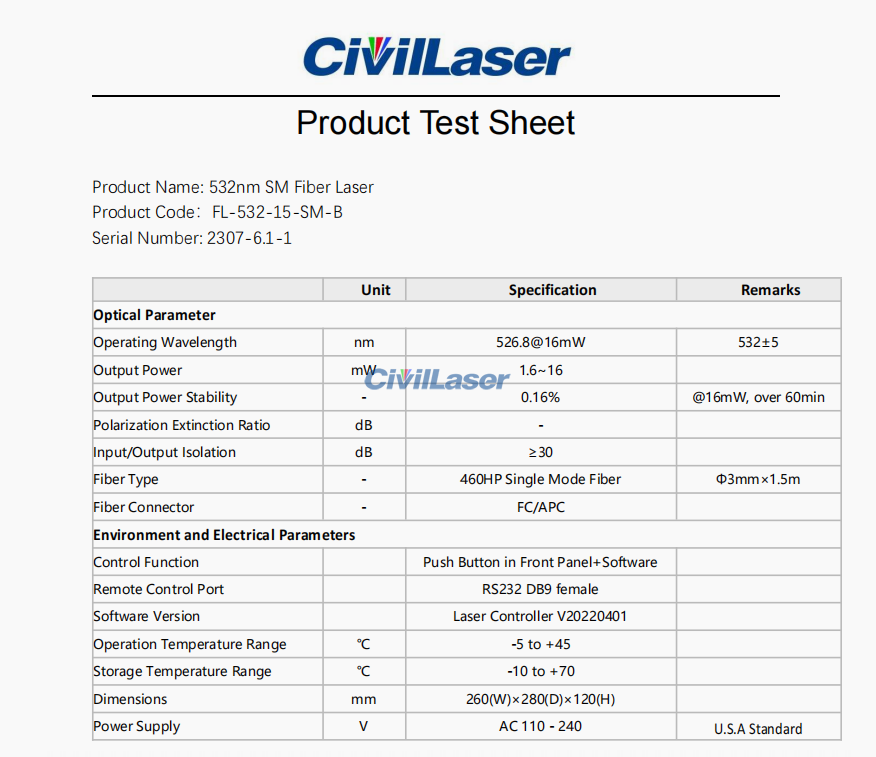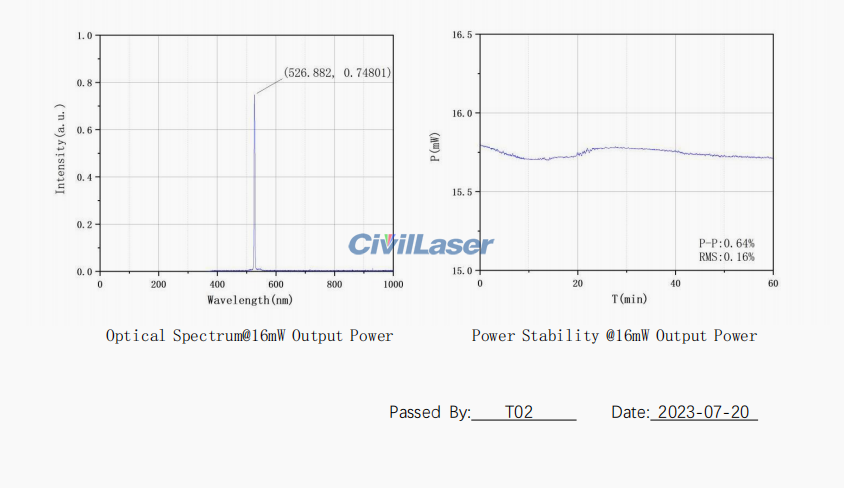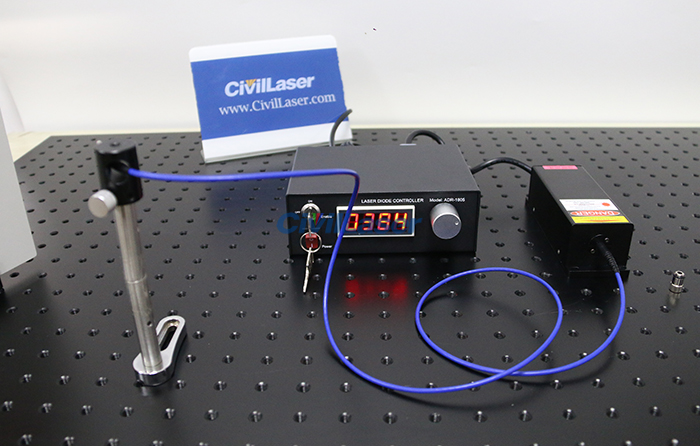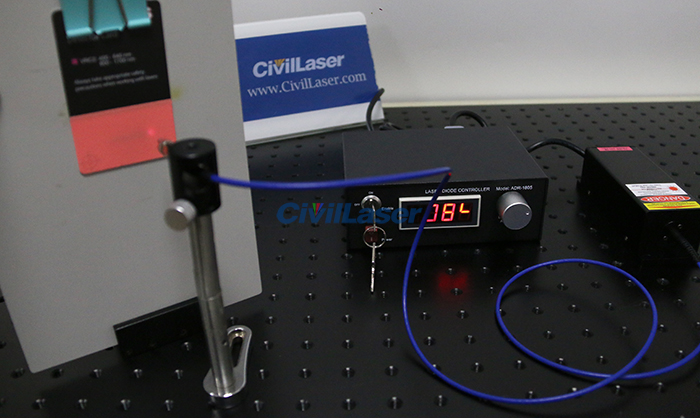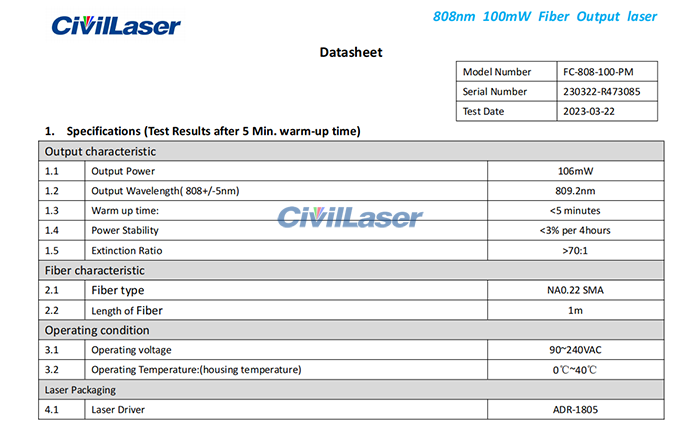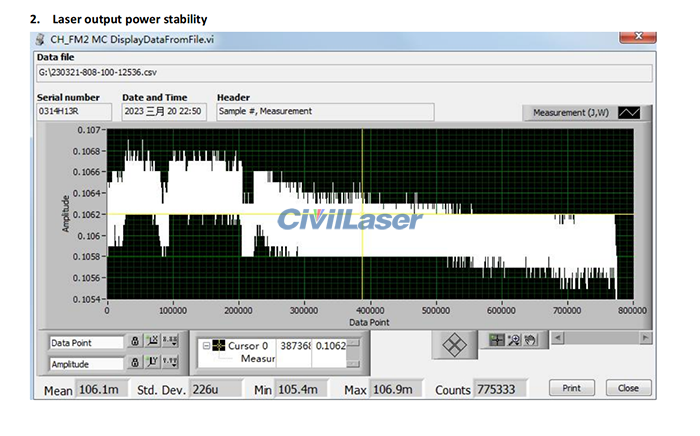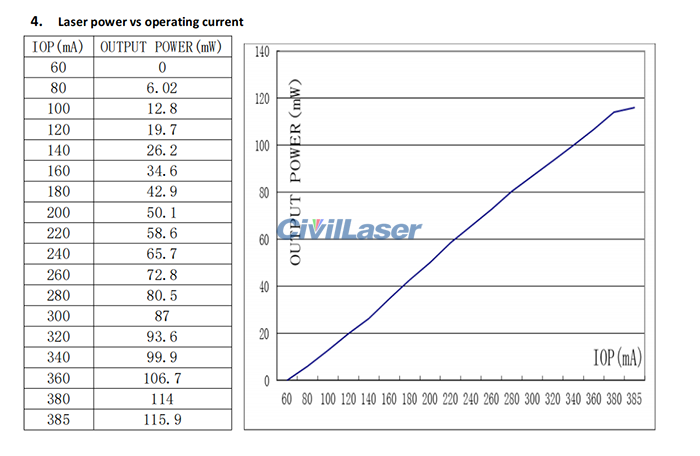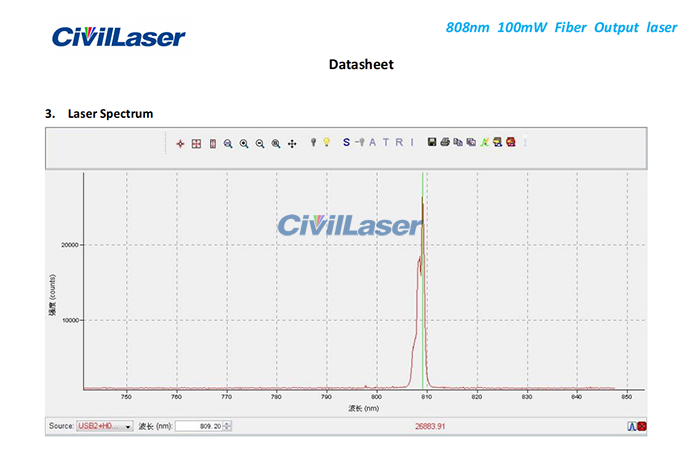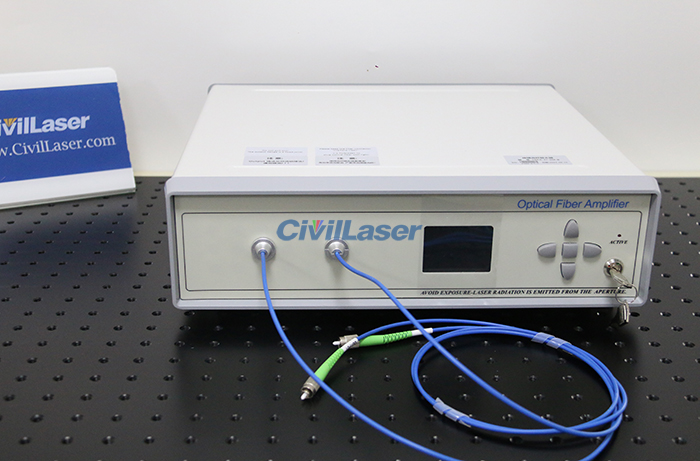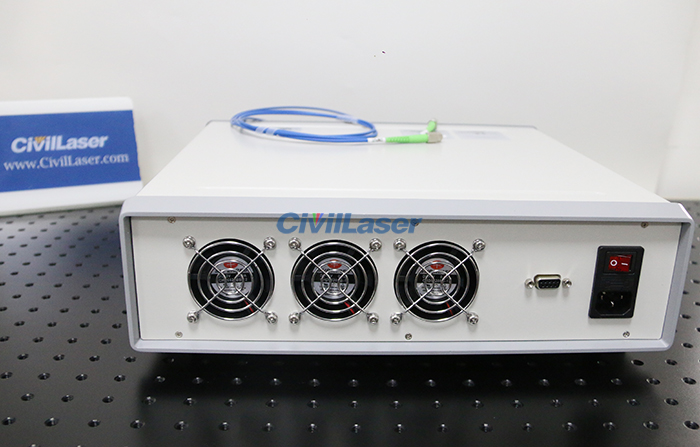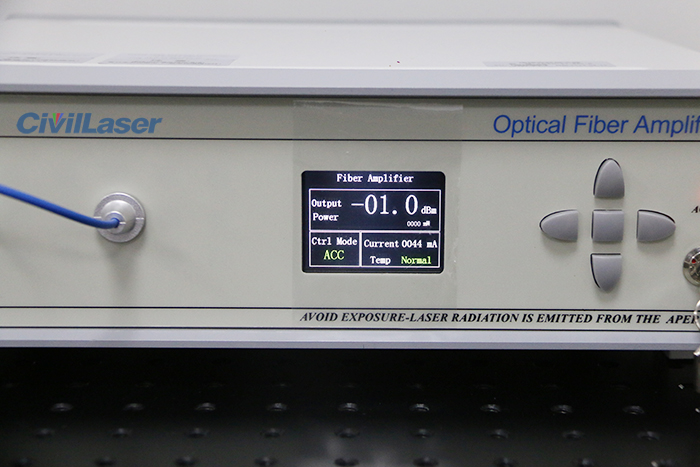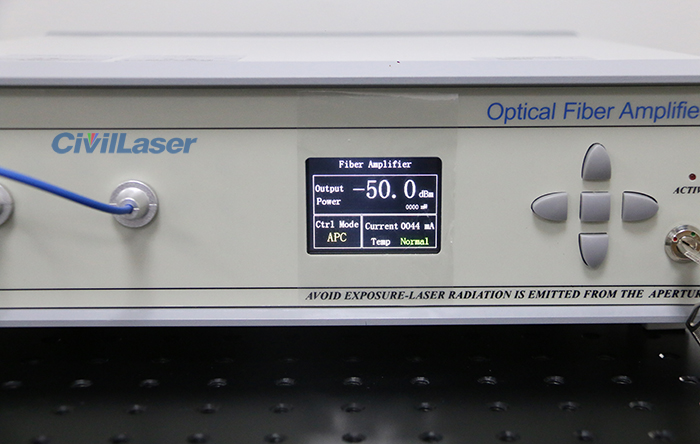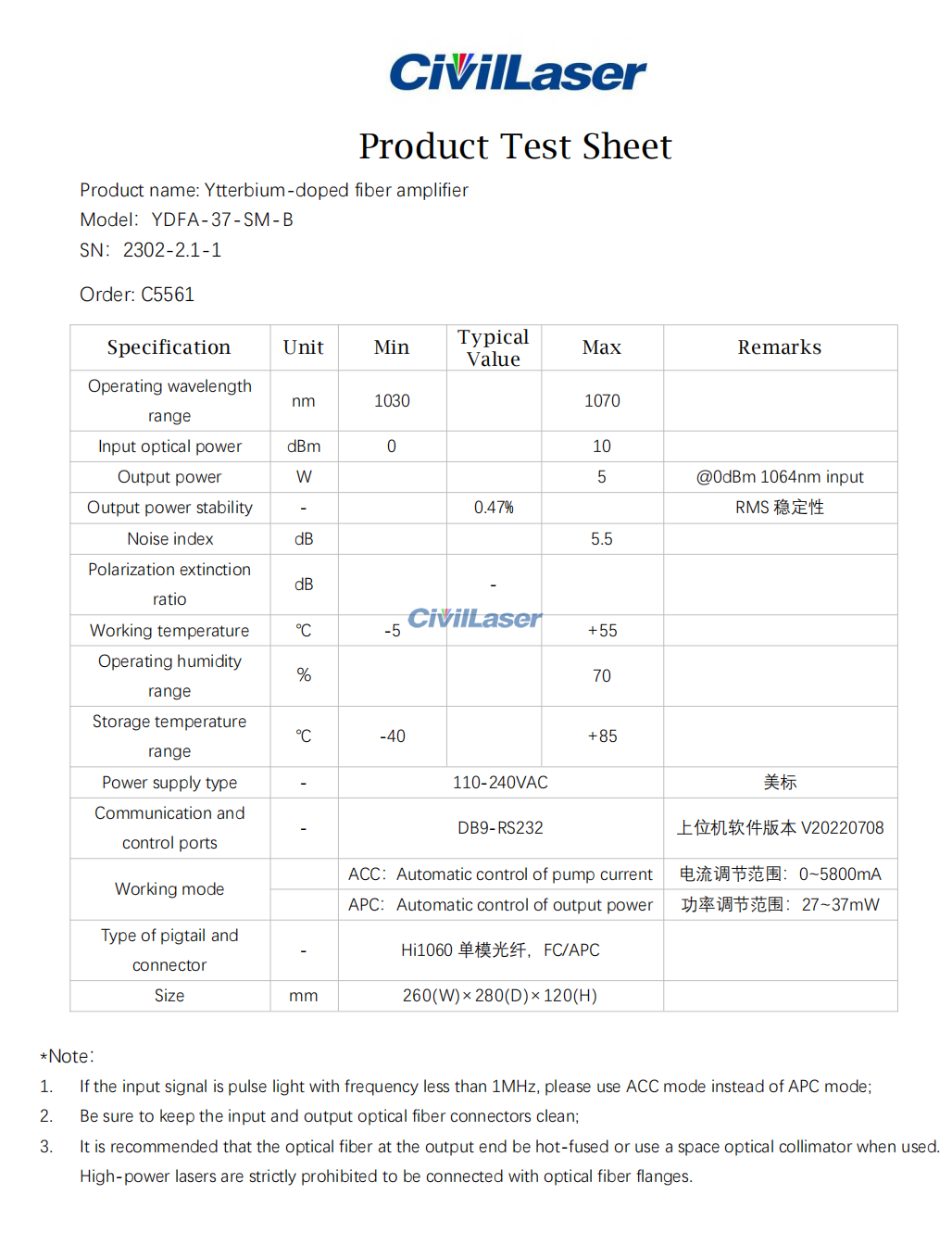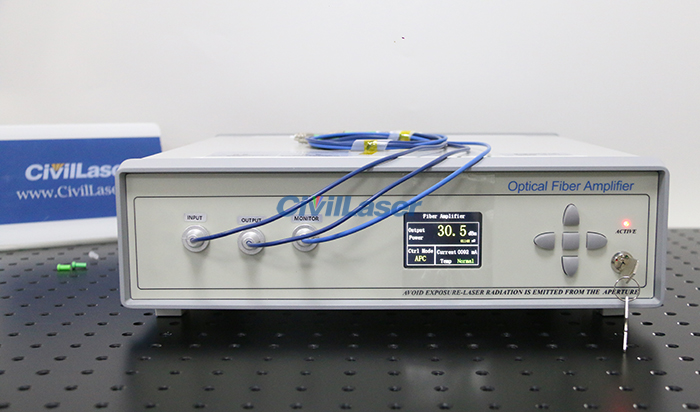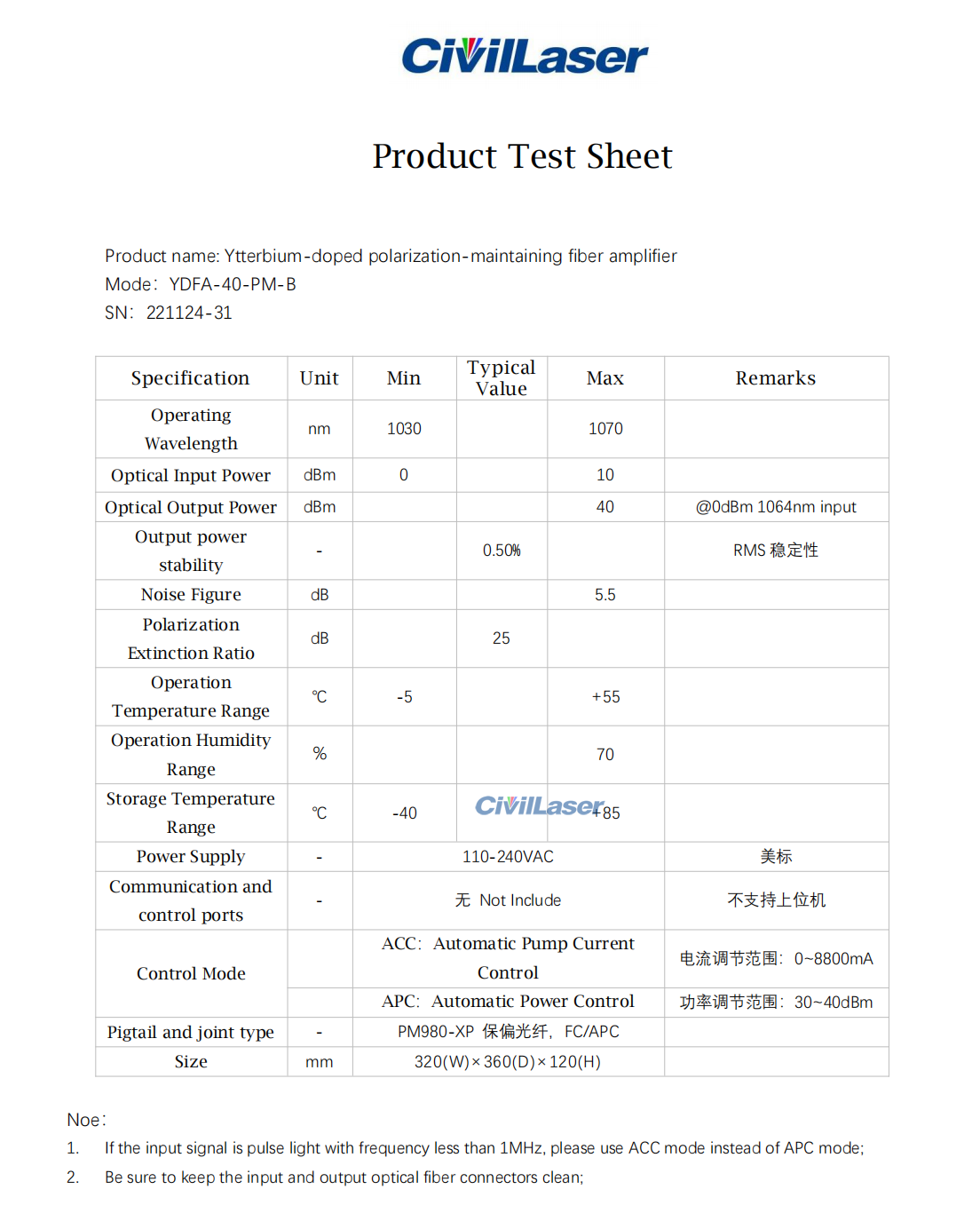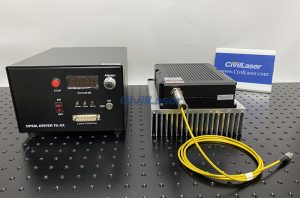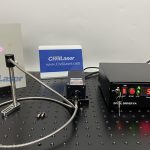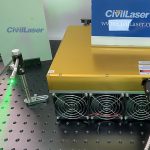Tag Archives: fiber laser source
CivilLaser’s 808nm 70W High Power Fiber Laser
Today we will introduce an 808nm 70W high-power fiber-coupled laser. The laser module generates a lot of heat. A heat dissipation module is installed at the bottom of the laser module, equipped with 3 cooling fans. When connecting the laser module and the laser power supply, there is a small white interface on the data cable, which is used to power the cooling fan and needs to be connected. The fiber is a 400um high temperature resistant fiber. One end of the fiber is fixed on the laser. The fiber coupling efficiency is about 85%, and the output power at the fiber end is 59W. Before turning on the machine, please wear infrared laser protective glasses.
The 808nm laser is an infrared laser. It is very weak when viewed with the naked eye, but the light spot can still be clearly captured with a camera.
In the field of modern scientific research, fiber lasers have become an indispensable and important tool. Choosing a fiber laser with stable performance and support for customization is crucial to the accuracy and innovation of scientific research results. In this regard, CivilLaser’s fiber lasers are undoubtedly the first choice of many scientific research institutions.
CivilLaser has many years of experience in laser R&D and manufacturing, and its fiber lasers are known for their excellent performance and stability. Whether used for high-precision experiments or long-running complex tests, CivilLaser’s fiber lasers can always maintain efficient and stable output, providing reliable data support for scientific researchers.
In addition, CivilLaser has a deep understanding of the diverse needs of scientific research work and provides flexible customized services. Whether it is wavelength, power, or interface design, CivilLaser can tailor solutions according to users’ specific needs to help scientific research institutions better achieve experimental goals.
It is worth mentioning that CivilLaser’s fiber lasers have been widely used by many well-known scientific research institutions around the world. Its products are not only leading in technical performance, but also win the high trust of users with high-quality after-sales service.
If you’re looking for a reliable, customizable, industry-proven fiber laser, look no further than CivilLaser. We are committed to providing excellent fiber laser products to scientific researchers around the world and working with you to promote scientific progress.
Unlocking High-speed Transmission: In-depth Analysis of 40dBm Single-mode YDFA Technology
Ytterbium-doped fiber amplifier (YDFA) generates gain by pumping ytterbium-doped fiber with semiconductor laser and is used to amplify optical signals in the 1030~1080nm band. The output power is continuously adjustable and has the advantages of high gain and low noise. The desktop YDFA is convenient for experimental operation, and the user can adjust the pump current and output power through the panel buttons. A more compact modular YDFA is also provided to facilitate user system integration.
With the rapid development of optical communication technology, how to effectively enhance the intensity of optical signals and extend the transmission distance has become the focus of the industry. As an important technological innovation in this field, the ytterbium-doped fiber amplifier is gradually becoming a key device in the construction of optical communication networks with its excellent performance and broad application prospects.
The 40dBm ytterbium-doped fiber amplifier uses advanced ytterbium-doped fiber as the gain medium. Ytterbium is widely used in fiber amplifiers due to its unique energy level structure and efficient energy conversion characteristics. When pump light (usually high-power laser) is injected into ytterbium-doped fiber, ytterbium atoms absorb the energy of the pump light and undergo energy level transitions. Subsequently, when the optical signal passes through the fiber, the ytterbium atoms are stimulated to radiate photons of the same frequency as the signal light, thereby amplifying the optical signal.
It is a 1030~1070nm Ytterbium-doped fiber amplifier. The saturated output power is 40dBm @0dBm input. The 40dBm YDFA is a high-power amplifier, with an additional Monitor interface. The Monitor is used to monitor or synchronize signals with low power. And it has built-in cooling fan. Configured with RS2323 interface, available software or control command YDFA.

It supports two working modes of APC/ACC, and the two working modes can be switched by pressing the button. In APC working mode, the output power can be set. In ACC working mode, the working current can be set. Finally, press the middle square button to confirm.
The use of single-mode optical fiber as the transmission medium ensures high-quality transmission of optical signals. Single-mode optical fiber has small intermodal dispersion and is suitable for long-distance, high-speed optical communication applications.
The test data of YDFA-40-SM-B.




The 40dBm ytterbium-doped fiber amplifier has shown strong competitiveness and broad market space in the field of optical communication with its excellent performance and wide application prospects. With the continuous advancement of technology and the continuous growth of application demand, it is believed that this technology will play a more important role in the future and promote the rapid development of the optical communication industry.
1550nm 1MHz Narrow Linewidth Laser SM Fiber Output
The 1550nm band single-wavelength laser (low power) adopts high-stability semiconductor laser chip, single-mode fiber output, professionally designed drive and temperature control circuit control to ensure the safe and stable operation of the laser.
This is 1550nm SM Fiber laser Benchtop. The output fiber SM or PM is optional, here is equipped with SM fiber. Its laser output power is adjustable, the adjustment accuracy is 1mW, and the adjustment range is 10~100%. And it supports button control and software control. The software control interface.
The laser test data of this narrow linewidth fiber laser system.
The laser line width test, 0.64 MHz.
405nm Blue-viole Laser Coupled SM Fiber Output
This is a 405nm 80mW single mode fiber laser desktop type. The real-time power is displayed on the LCD screen, and the power can be adjusted by the button on the left.
It can also be customized into modules and controlled by software. Desktop reserved RS232 interface, software control function can be added. This laser quipped with single-mode fiber, PM fiber can also be customized. The fiber output interface is FC/APC by default, and can also be customized with SMA, FC/PC and other models.
The test data sheet of 405nm 80mW laser.
Adjust the laser output power via the button:
Use the left and right buttons to select the value position to be adjusted.
The upper and down buttons adjust the value.
The middle square button determines the adjustment setting.
1550nm 1MHz Spectral Linewidth Laser PM1550 Fiber Output
The 1550nm band single-wavelength laser (low power) adopts high-stability semiconductor laser chip, single-mode or polarization maintaining fiber output, professionally designed drive and temperature control circuit control to ensure the safe and stable operation of the laser.
It is a 1550nm 20mW fiber laser source benchtop. PM1550 polarization maintaining fiber is installed, and SM single-mode fiber can also be customized. The output power can be adjusted, and the adjustment accuracy is 0.1mW. This is a narrow linewidth laser with a spectral bandwidth of less than 1MHz. Narrow linewidth lasers at the kHz level can also be customized.
Software control function can be customized,using RS232 communication serial port. Default only supports button control. The standard version is controlled by buttons to control the switch and adjust the power.
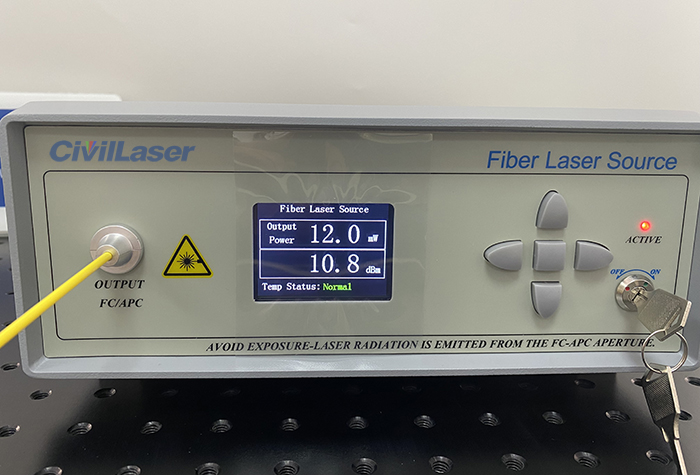
The test report for this fiber laser.
TEM00 Lab Laser 532nm 15mW SM Fiber Laser Source
The demonstration in our laboratory this time is a 532nm 15mw single-mode fiber laser. It has an LCD display to show the current power of the laser. The output power of this laser can be adjusted from 10% to 100%, and the adjustment accuracy is 0.1mW. Let’s check it now.
The back of the laser has an RS232 interface. It can be customized for software control functions. The key controls the ON/OFF of the laser. Here is SM fiber, and PM fiber can also be customized.
The test data report of 532nm single mode fiber laser.
Laser spectrum graph and power stability test report.
This laser adopts semiconductor laser chip, and the professionally designed drive and temperature control circuit temperature control ensures the safe operation of the laser, stable output power and spectrum, and excellent spot quality (TEM00 mode).
808nm 100mW Semiconductor Laser Coupled PM Optical Fiber
808nm fiber-coupled laser uses PM fiber coupling, which has the advantages of high coupling efficiency and good output laser beam quality. The TEC temperature control system is used to ensure that the laser is more stable and has better performance. Compact structure, strong and reliable, suitable for various industrial and scientific research applications.
This is 808nm 100mW infrared lab laser system coupled PM fiber. The working voltage is AC 90~240V and supports wide range voltage. Its laser power can be adjusted from 0~100mW, and it supports two working modes of CW/Modulation.
808nm is infrared laser, invisible laser, here use infrared sensitive film to observe the spot.
The test report of 808nm 100mW IR PM fiber coupled laser system.
37dBm Yb-doped SM Fiber Amplifier Benchtop
It’s a high power Ytterbium-doped optical amplifier, its output power is 37dBm. And high power YDFA built-in 3 cooling fans. The software control function can be customized, and the default is button control. The current working mode, current and output power are displayed on the front display.
It supports APC and ACC two working modes, and the two modes can be switched. In ACC mode, the working current can be adjusted. In APC mode, the output power can be adjusted.
The test report of YDFA-37-SM.
1030~1100nm 10W PM Optical Fiber Amplifier YDFA
Ytterbium-doped fiber amplifier (YDFA) generates gain by pumping ytterbium-doped fiber with a semiconductor laser, and is used to amplify laser signals in the 1030~1100nm band. PM980 polarization-maintaining fiber output, the output power is continuously adjustable, and has the advantages of high gain and low noise. The desktop YDFA is convenient for experimental operation, and the user can adjust the pump current and output power through the buttons on the front panel. A more compact modular YDFA is also available, which is convenient for users’ system integration. Both desktop YDFA and modular YDFA can support PC software control and serial port command control.
The following video explains the 40dBm polarization maintaining YDFA becnhtop. It supports APC and ACC two working modes can be switched. In APC mode, the output power can be adjusted. In ACC mode, the working current can be adjusted. Let’s check it now.
It’s a high power polarization maintaining ytterbium-doped optical amplifier. Civil Laser’s 10W high power YDFA include a ‘Monitor’ fiber. The software control function can be customized, and the default is button control. The working current or output power can be adjusted by the button.
YDFA’s test report.
520nm 22W Lab Laser Fiber Output PC Control
This is 520nm high power green fiber laser system. This laser adds software control. Use RS232-USB to connect the laser and computer software.The laser output power can be adjusted by software. Using EasyHost software, you can also write your own programs to control the lower computer according to the communication protocol.
The output power is 22W laser, it is a high-power laser, we added a heat sink under the laser module. The heat sink is composed of aluminum sheets and 3 cooling fans. Its fiber is pluggable, here we choose a 1000μm fiber. Let’s check it now.
Software Operation:
Click ‘Open COM’, the software links the lower computer control circuit of the laser. When starting the software for the first time, set the maximum current first, and set a maximum current value according to the laser test report. If the current is too large, it is easy to burn out the laser chip. For each laser, the maximum current must be set first.








